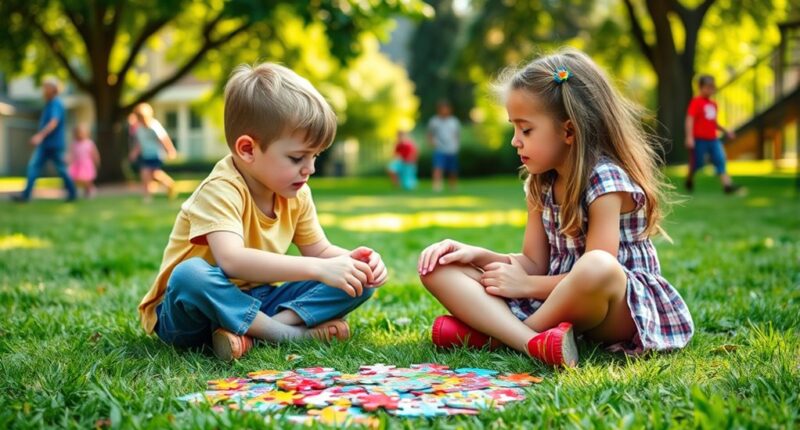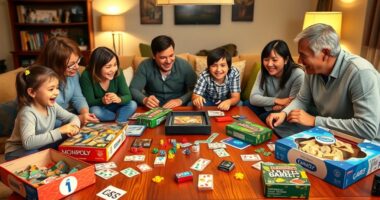Teaching kids to handle disagreements starts with understanding conflict as a normal part of growing up. Equip them with calming strategies, like deep breathing and visualization, to manage strong emotions. Encourage effective communication through active listening and “I” statements to enhance empathy. Introduce problem-solving techniques, and practice conflict resolution skills. Reinforcing these strategies helps kids develop healthy relationships. You’ll discover more techniques to empower your child in managing conflicts successfully.
Key Takeaways
- Teach children calming strategies like deep breathing and visualization techniques to manage emotions during conflicts.
- Encourage effective listening and the use of “I” statements to express feelings without blame.
- Utilize role-playing scenarios to develop empathy and problem-solving skills in a safe environment.
- Incorporate interactive activities and worksheets to facilitate understanding of conflict resolution processes.
- Celebrate successful conflict resolutions to reinforce positive behaviors and encourage continuous practice.
Understanding the Nature of Conflict
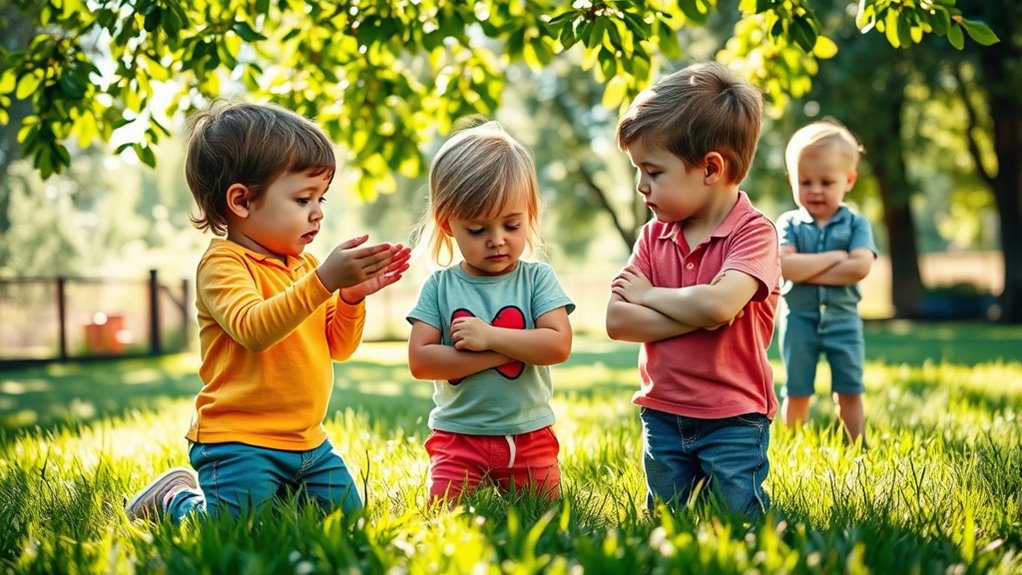
Understanding the nature of conflict is essential, especially since it’s a normal part of growing up. Conflict arises from disagreements, differing perspectives, or competing needs among children. You’ll notice it often in playground disputes, sibling rivalries, and even classroom settings. These situations evoke strong emotions like anger or frustration, which can be overwhelming for kids. However, conflicts also serve as valuable learning opportunities. They help children develop important skills such as communication and problem-solving. Understanding that parent-child conflicts often stem from differences in values and expectations can also aid in navigating these situations more effectively. Recognizing the importance of emotional alignment can help children manage their feelings during disagreements, fostering healthier interactions. Moreover, developing emotional resilience through conflict resolution can empower children to cope with challenges more effectively. Additionally, learning to communicate openly about grievances can provide children with essential tools for resolving conflicts and enhancing their relationship skills. Engaging in conflict resolution practices can also encourage children to adopt healthy communication styles that will benefit them in future interactions. For instance, understanding that astrological compatibility can influence emotional responses may help children navigate conflicts with empathy and awareness.
Calming Strategies for Kids

When conflicts arise, having effective calming strategies at your fingertips can make all the difference for kids. Start with deep breathing techniques, like “hot cocoa breathing” or “roller coaster breathing,” to help reduce anxiety and promote relaxation. Encourage short breaks, allowing kids to step away to regain composure and reflect. Utilizing physical objects, such as stress balls or fidget toys, can provide relief by redirecting energy. Visualization techniques also work well; guide them to imagine peaceful places or outcomes to alleviate tension. Additionally, understanding the emotional dysregulation that can occur during conflicts can help kids better navigate their feelings. Establishing a supportive environment that emphasizes community support can further empower children to manage their conflicts more effectively. Incorporating mindfulness practices, such as those learned in spiritual retreats, can also enhance their ability to stay calm and focused during disagreements. Finally, establish consistent routines that incorporate calming practices, reinforcing their importance. These strategies not only help during conflicts but also teach valuable self-regulation skills for the future, as research shows social-emotional learning (SEL) significantly improves children’s conflict resolution skills. Furthermore, integrating predictive modeling can provide insights into students’ emotional responses, enhancing their ability to manage disagreements effectively. Additionally, incorporating positive thinking techniques can further enhance their ability to navigate disagreements effectively.
Essential Communication Skills
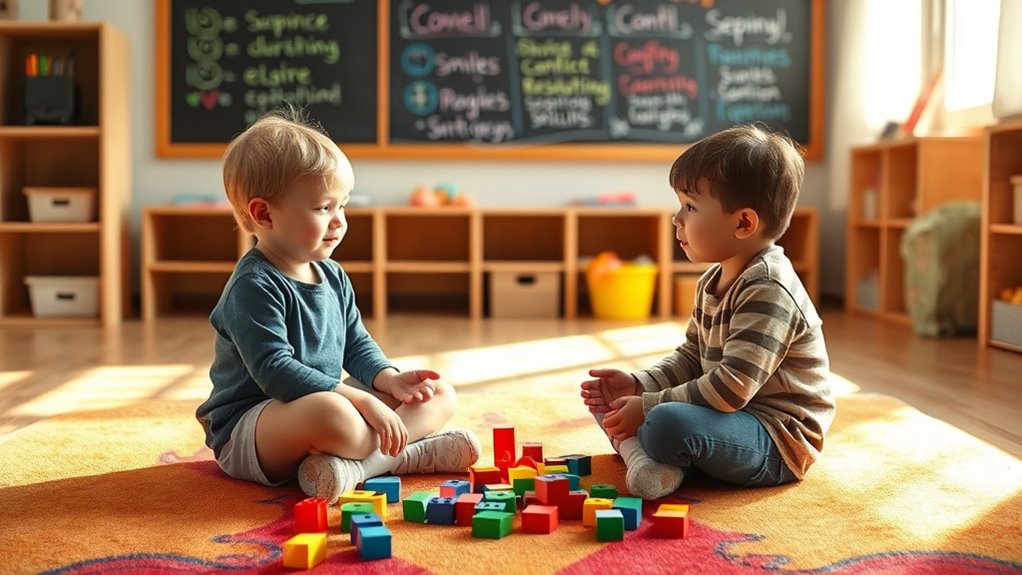
Calming strategies set the stage for effective communication during conflicts. To resolve disagreements, you need crucial communication skills.
Start with effective listening; focus on what the other person says without interrupting. This encourages understanding and empathy. Clear expression is essential, too—articulate your feelings and needs without escalating tensions. Practicing active listening reinforces the importance of feeling heard and valued during disagreements. Incorporating AI technologies can also enhance communication skills by providing personalized feedback during practice sessions. Additionally, recognizing emotional dysregulation can help you manage your reactions during heated discussions. It’s important to stay hydrated as well, as proper hydration supports optimal brain function during stressful conversations. Furthermore, being aware of narcissistic behavior in communication can help navigate interactions more effectively. Engaging in mindfulness practices can further enhance your ability to remain calm and focused during conflicts.
Always engage in respectful dialogue; using kind language promotes peaceful exchanges. Building empathy helps you grasp others’ perspectives, reducing misunderstandings.
Practice using “I” statements to express emotions without casting blame, while also modeling this behavior in daily conversations. Constructive feedback is key; learn to give and receive it in a positive way.
Together, these skills create a supportive environment for resolution and growth.
Problem-Solving Techniques
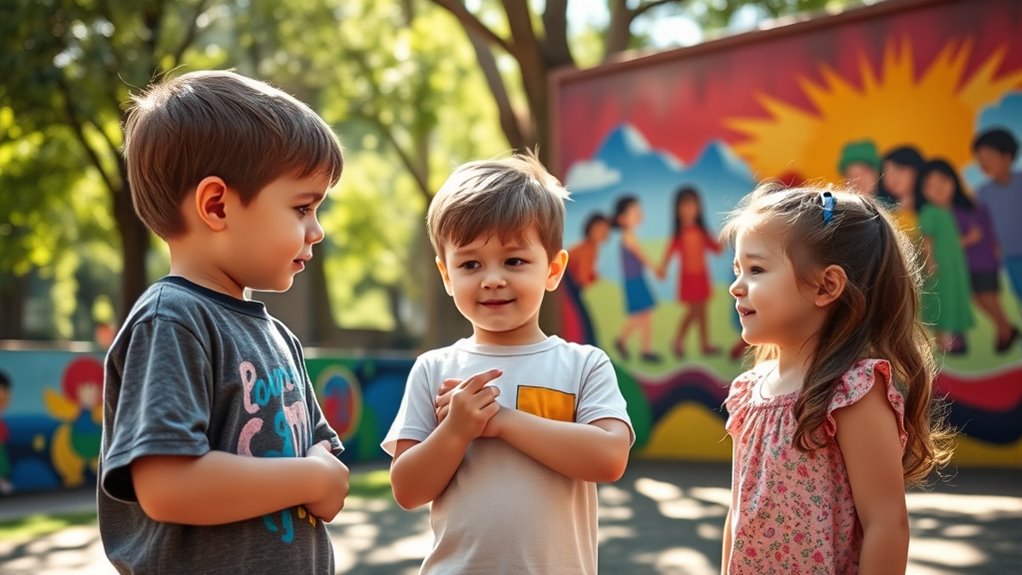
Steering through conflicts effectively requires mastering problem-solving techniques that empower kids to address disagreements constructively. Start by helping them recognize their emotions using tools like an “emotion chart.” This awareness fosters thoughtful communication. Additionally, understanding family caregiver contracts can help them appreciate the importance of clear communication and expectations in any relationship. In this context, it’s essential to remember that unconditional love can provide a safe space for kids to express their feelings without fear of judgment.
Moreover, engaging in community collaboration can enhance their understanding of diverse perspectives during conflicts, similar to how pet therapy can improve emotional well-being for those facing challenges. Providing them with opportunities for social interaction can also encourage teamwork and shared problem-solving skills. Next, guide them to brainstorm multiple solutions, discussing the pros and cons to encourage critical thinking and collaboration. Active listening is essential too; teach them to make eye contact, summarize, and validate each other’s feelings. Healthy conflict resolution is a critical life skill that can be developed through practice.
Role-playing scenarios can further develop empathy and problem-solving skills in a safe environment. Finally, emphasize the importance of reflection and reinforcement. Encourage kids to share their experiences, discuss what worked, and celebrate their successes to build confidence in handling future disputes.
Steps in Conflict Resolution

Effective conflict resolution starts with clearly identifying the conflict at hand.
Begin by recognizing the source of the disagreement and involving children in understanding the issue. Identify the conflicting parties and their interests, and determine if adult intervention is necessary for safety. Encourage children to express their feelings about the conflict, setting ground rules to prevent escalation, as emotional neglect can exacerbate misunderstandings. Establishing a safe environment is crucial, as it helps children feel secure and supported while navigating their emotions. Additionally, fostering emotional regulation skills can empower children to manage their feelings more effectively during conflicts. Understanding the impact of cultural intelligence can also help children appreciate different perspectives in diverse settings. Implementing effective communication techniques can further enhance children’s ability to resolve disputes constructively.
Once emotions are calmed, help them communicate effectively using “I” statements and practicing active listening. This includes showing empathy, which helps children acknowledge others’ feelings and perspectives.
Engage kids in brainstorming solutions, weighing the pros and cons, and encouraging win-win negotiations.
Finally, guarantee that agreed-upon solutions are implemented and monitored for effectiveness. Celebrate their efforts in resolving conflicts, reflecting on what they learned throughout the process.
The Role of Empathy in Disagreements

Empathy plays an essential role in resolving disagreements among kids, helping them see situations from others’ perspectives. When you encourage your child to practice empathy, they’ll start recognizing different viewpoints, addressing the root causes of conflicts effectively.
This understanding promotes better communication and allows them to manage their emotions calmly during disputes. As your child develops empathy, they’ll form stronger bonds with peers and family, leading to healthier relationships.
Empathetic children embrace diversity, fostering an inclusive mindset while reducing feelings of loneliness. By nurturing empathy, you’re equipping your child with the skills necessary to compromise and find mutually satisfying solutions during disagreements, ultimately enhancing their emotional intelligence and social interactions.
Educational Activities for Conflict Management

Building on the foundation of empathy, kids can benefit from engaging in educational activities that promote conflict management skills.
Conflict resolution worksheets help them identify problems and brainstorm solutions, while games like Conflict Freeze and Conflict Bingo encourage role-playing and sharing personal experiences.
Conflict resolution worksheets foster problem identification and solution brainstorming, while engaging games promote role-playing and personal experience sharing.
Interactive role-playing activities, such as What Would You Do?, allow students to explore various perspectives.
Problem-solving tasks like the Decision Matrix help them evaluate solutions critically.
Creative options, including puppet shows and story-based discussions, teach empathy and verbalization skills.
Finally, simple activities like Rock, Paper, Scissors can resolve minor disputes playfully.
These engaging methods make learning about conflict management both fun and effective, empowering kids to handle disagreements confidently.
Encouraging Positive Relationships Through Resolution
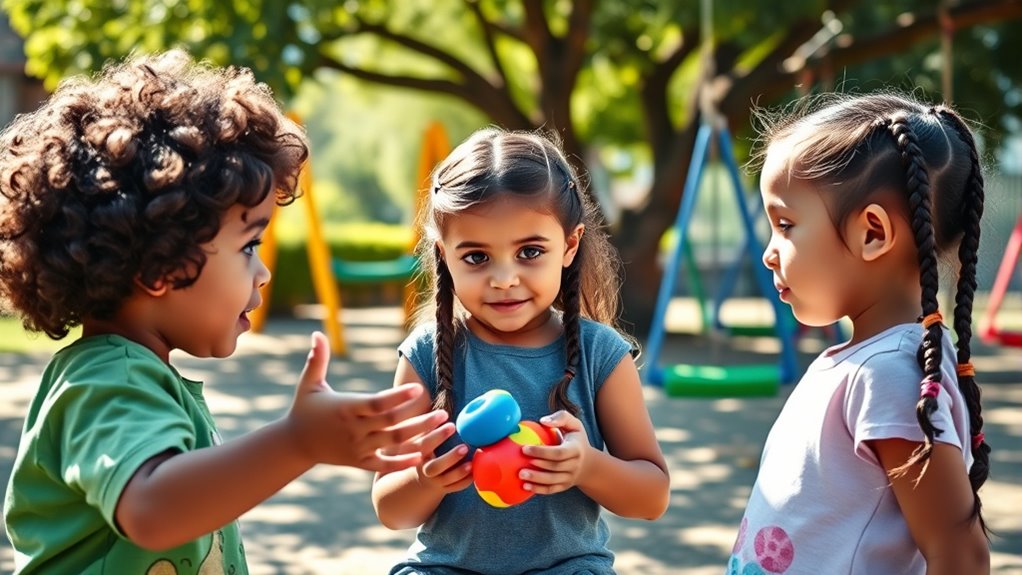
While conflicts are a natural part of relationships, resolving them positively can strengthen bonds and foster emotional growth.
By focusing on emotional intelligence and empathy, you can teach your child to navigate disagreements with understanding. Encourage them to express their feelings using “I” statements, which reduces defensiveness and opens up communication.
Role-playing different scenarios helps build empathy, allowing your child to appreciate others’ perspectives. This creates a foundation of mutual respect and trust.
When children practice problem-solving skills, they learn to find solutions that benefit everyone involved. Reinforcing these strategies boosts their confidence and resilience, leading to healthier interactions.
Ultimately, effective conflict resolution not only enhances self-efficacy but also promotes lasting, positive relationships.
Frequently Asked Questions
How Can Parents Help Children Practice Conflict Resolution at Home?
To help your children practice conflict resolution at home, create a calm environment where discussions can happen safely.
Encourage them to express feelings using “I-statements” and practice active listening.
Role-play different scenarios to build communication skills.
Guide them in brainstorming solutions and evaluating options together.
Model patience and empathy during conflicts, sharing your own experiences.
What Age Is Appropriate to Start Teaching Conflict Resolution Skills?
You can start teaching conflict resolution skills as early as two years old. At this age, kids can grasp basic concepts with your guidance. Use simple language to redirect and model positive behaviors.
As they grow, introduce more complex strategies, like role-playing and emotional regulation. By integrating these lessons into daily interactions, you’ll help them develop essential skills for handling disagreements effectively throughout their lives.
How Do Cultural Differences Affect Conflict Resolution Among Children?
Imagine a bustling playground where kids navigate friendships and disagreements.
Cultural differences shape how they handle conflicts. If you’re from a collectivist culture, you might tiptoe around tensions, valuing harmony. In contrast, if you hail from an individualistic background, you may confront issues head-on.
These diverse approaches reflect your upbringing, illustrating that conflict isn’t just a battle; it’s a chance to understand each other, learn, and foster cooperation in your community.
What Signs Indicate a Child Needs Help With Conflict Resolution?
You might notice several signs that indicate a child needs help with conflict resolution. Frequent emotional outbursts, difficulty calming down, or overreacting to minor disagreements are key indicators.
They may struggle to express their feelings verbally, resorting to physical actions instead. If you see them withdrawing from social situations or experiencing changes in mood, eating, or sleeping patterns, these could signal deeper issues.
Addressing these signs early can make a significant difference.
How Can Schools Support Conflict Resolution Education for Students?
Imagine a garden where seeds of understanding bloom, transforming misunderstandings into vibrant connections.
Schools can nurture this garden by integrating conflict resolution education through programs like peer mediation and restorative practices. They can train teachers to model effective communication, creating a ripple effect of positive interactions.
Engaging activities can turn lessons into adventures, while community involvement can strengthen the roots, ensuring that every child thrives in a supportive, harmonious environment.
Conclusion
In teaching kids to handle disagreements, you’re planting seeds of understanding that can blossom into strong, respectful relationships. Imagine them, like skilled gardeners, nurturing their communication skills and empathy, transforming conflicts into opportunities for growth. As they learn to navigate differences, they’ll build bridges instead of walls, creating a vibrant landscape of collaboration and kindness. With your guidance, they’ll flourish, turning every disagreement into a stepping stone toward harmony and connection.
